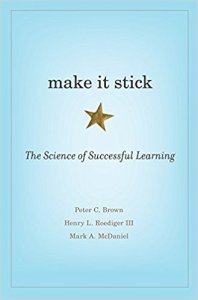
At last—the recipe for limitless, lifelong learning (and remembering) is here! Ingredients include: bean bags, buckets, Mark Twain, England’s monarchs, and some elbow grease.
Brown, Peter C., Henry L. Roediger III, and Mark A. McDaniel. Make It Stick: The Science of Successful Learning. Cambridge, MA: Belknap Press of Harvard UP, 2014. Print.
Genre: nonfiction
Summary: Researchers Henry Roediger and Mark McDaniel compile recent findings from neuroscience and cognitive psychology. Writer Peter Brown translates the science into laymen terms as the experts combine the results to reexamine what learning is how best to facilitate it.
Critique: Despite roaming through complex fields like neurology and psychology, this book never feels dense or esoteric. In arranging the content for each chapter, the co-authors also cleverly employ the optimal learning methods they discover. As a result, information snowballs. The reader re-encounters and continually retains more and more of the book’s core concepts. Done poorly, this technique can become a broken record. Here, it always arrives fresh as Farmer’s Market produce.
The authors’ primary goal is to upend the “golden rules” about how we think we learn. Conventionally, we believe that learning anything “the hard way” is a waste of time and effort. The student and teacher are better off when the learning is fast and easy. We also believe that practice makes perfect. Repeat something over and over AND OVER until you have it down. However, like nearly all the revelations arising from fMRI (real-time observations of living brains) evidence, the takeaways on learning are counterintuitive and quite opposite from the quick-and-easy conventions.
The Make It Stick authors reveal that when it comes to learning, easy in equals easy out. For example, whenever someone tells you a phone number, you might repeat the number over and over until you can plug it into your phone or jot it on a piece of paper. If asked to recite the number again later that day, odds are good you would succeed in the memory task. But, if asked to recall the number days or weeks later, odds are you will have forgotten the number entirely.
Why?

Because the brain stores quick and easy info in short term memory. Think of short term memory like a chalkboard. It’s as easy to mark on as it is to wipe clean. Long term memory is more like a safety deposit box. It will cost you to put anything in it, but once there, it will endure.
The cost required to store anything in long term memory is effort. Learning actually needs to be effortful if it’s going to last, expand, and enrich.
How can we make learning meaningfully effortful? The authors recommend “interleaving” or mixing the tasks and skills to be practiced. Their example comes from a study of youngsters challenged to master the art of chucking a bean bag into a bucket two feet away. One group of kiddos practices exactly that: lobbing bags at a bucket set two feet away. Over and over in the usual “practice makes perfect” style—or what learning specialists call “massed” practice. The other group interleaves their learning. Their buckets sit three feet and four feet away and they can shoot at either or both targets as mixed or as methodically as they wish.

On an immediate skills test, the first group nailed the two-foot bucket more often than the second group. However, within a few weeks without additional practice, the first group missed the target while the second group nailed it. The interleaved practice was more difficult and did not produce desired results immediately, but it built a wider range of skills thanks to mixed targets. Over time, the brain massaged all that learning into the physical finesse needed to land the shot, regardless of the bucket’s distance.
Another vital point which contradicts convention concerns forgetting. We assume forgetting stems from a flaw in our ability to remember, or that the way we acquired the information was somehow flawed (otherwise, we would remember it). On the contrary, forgetting is what the brain does naturally and needs to do in order to acquire information for the long term.
How can we encourage beneficial forgetting? Build open spaces or gaps into the learning process. Following a lesson, allow for a gap in time and attention on the topic. Allow the brain to erase some or most of what you acquired. Then quiz yourself. The effort you put into reconstructing the lesson strengthens the wiring in and across your brain. To recall what you learned (and partially forgot), you must tap various regions of the brain—those governing sound, smell, touch, taste, and so on. Your prior learning and experience will also feed the reconstruction process, which in turn, bolsters the wiring (synaptic connections) around the new information. More connections equal deeper storage and longer retention.
So, how do Mark Twain and England’s monarchs factor into durable learning? You’ll see (and likely never forget) when you read the book.
Comments